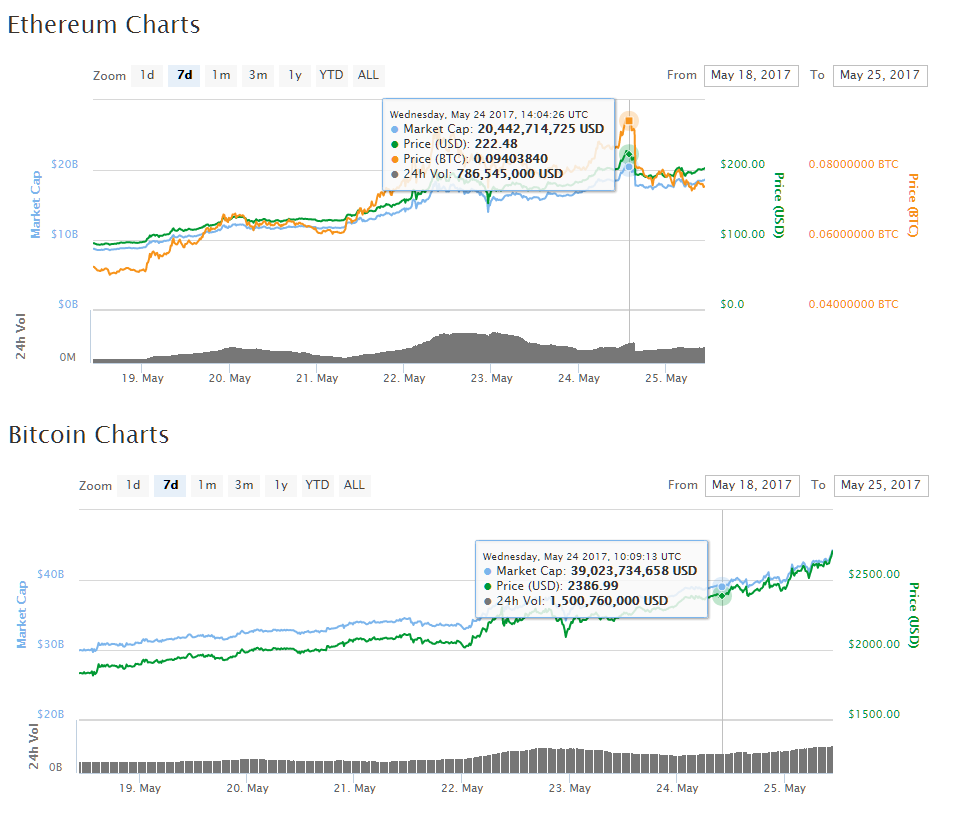Ethereum Briefly Accounts For 50% of Bitcoin’s Market Cap After Strong Rally
After surpassing the market cap of Ripple and reclaiming its spot as the second largest cryptocurrency or cryptoasset, Ethereum’s market cap briefly accounted for 50 percent of bitcoin’s market cap.
On May 24, Ethereum’s market cap surpassed the $20 billion mark for the first time, demonstrating a record high $800 million daily trading volume. During that time, Bitcoin’s market cap stabilized at around $39 billion, which allowed Ethereum to secure a market cap that was over 51 percent to that of Bitcoin’s.
 Although Ethereum’s market cap and value have declined slightly since then, by around $1.3 billion, it still remains as the dominant second largest cryptocurrency behind bitcoin, with a market cap of $18 billion, which is $8 billion higher than the distant third largest cryptoasset Ripple.
Although Ethereum’s market cap and value have declined slightly since then, by around $1.3 billion, it still remains as the dominant second largest cryptocurrency behind bitcoin, with a market cap of $18 billion, which is $8 billion higher than the distant third largest cryptoasset Ripple.
There exist several reasons why Ethereum (ETH) has surged significantly since the beginning of 2017. The majority of ETH traders and investors in have been investing and trading Ether due to the formation of the Enterprise Ethereum Alliance (EEA) and rising interest from institutional investors.
Mainstream media outlets including CNBC have extensively covered the explosive growth of the EEA and the value of Fortune 500 companies the EEA is in partnership with, including Toyota, ING, DTCC and Rabobank.
More importantly, CNBC analysts explained that the EEA and its platform are being actively utilized by large-scale companies such as Airbus and John Hancock Financial. CNBC revealed that John Hancock Financial is using the blockchain platform of EEA to track Know Your Customer (KYC) and Anti-Money Laundering (AML) policies while aircraft maker Airbus is using the decentralized protocol of Airbus to manage its supply chain.
The automation of regulations and policies using the decentralized blockchain of Ethereum is a concept that is being actively investigated by both the EEA and its participating companies. Specifically, Ethereum release coordinator Vinay Gupta emphasized the importance of regulation automation using Ethereum during his presentation to the European Parliament.
Gupta explained:
“The thing which would be most useful in all of this is if we had mechanical representations of law it would allow people to figure out whether what they wanted to do is compliant or not compliant very cheaply. This is an enormously powerful new growth area and the more work that could be done on creating software definitions of law that would allow people to automatically check when their programs are compliant, the better the future will be.”
The rising demand toward Ethereum and its applications from the companies within the EEA and institutional investors such as Fidelity Investments, which manages $2.13 trillion worth of assets, has allowed Ethereum to sustain its strong momentum and portray its growth through its rising market cap and price.
Some multi-billion dollar companies including Fidelity are so keen on discovering the potential of Ethereum to the point where they have started to mine Ethereum and utilize it to make payments, automate systems and optimize operations.
In an interview with Reuters, Fidelity Investments CEO Abigail Johnson said:
“I love this stuff – bitcoin, ethereum, blockchain technology – and what the future holds. We have built proofs of concepts that accept bitcoin microtransactions. We set up small bitcoin and ethereum mining operations, just done in the spirit of learning.”
Featured image from Shutterstock. For more Ethereum news, click here.